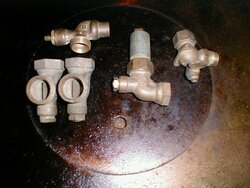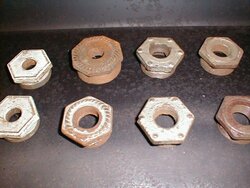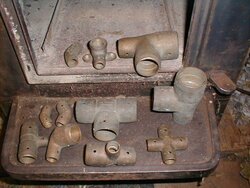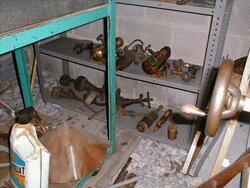I totally agree on the works of art opinion, coaly. And yep, some of those bushings are pretty elaborate. Pretty outrageous designs cast into some of those old rads and you're right, having a complete set in any house is worth a lot.
Cast Iron Radiator Connector Fitting
- Thread starter Eric Johnson
- Start date
-
Active since 1995, Hearth.com is THE place on the internet for free information and advice about wood stoves, pellet stoves and other energy saving equipment.
We strive to provide opinions, articles, discussions and history related to Hearth Products and in a more general sense, energy issues.
We promote the EFFICIENT, RESPONSIBLE, CLEAN and SAFE use of all fuels, whether renewable or fossil. -
Super Cedar firestarters 30% discount Use code Hearth2024 Click here
You are using an out of date browser. It may not display this or other websites correctly.
You should upgrade or use an alternative browser.
You should upgrade or use an alternative browser.
- Status
- Not open for further replies.
Here's a few of the adjustible type with shutters inside to balance flow; They come in straight and Tee too. To give you an idea of size, they are sitting on a 10 inch stove lid.
The one on the right has a drain petcock with mount ears.
I have buckets of these things, including brass railing parts. Too cool to scrap ! I bought the lot for Lunkenheimer parts, steam relief valves, whistles, and oilers. It came with a bench type threader, portable pipe vice on a long pipe with adjustable top to take into a basement and tighten against a floor joist llike a post, pipe vices that have a strap affair to prevent marring chrome and brass pipe, and large pipe cutters like a chain wrench with cutter wheels all the way around that cuts well casing and larger pipe very easily. $200 for the entire garage full in the 80's. Most of the stuff was from the 1920's and 30's. I bought it for the stuff from the 1800's ;
.
The one on the right has a drain petcock with mount ears.
I have buckets of these things, including brass railing parts. Too cool to scrap ! I bought the lot for Lunkenheimer parts, steam relief valves, whistles, and oilers. It came with a bench type threader, portable pipe vice on a long pipe with adjustable top to take into a basement and tighten against a floor joist llike a post, pipe vices that have a strap affair to prevent marring chrome and brass pipe, and large pipe cutters like a chain wrench with cutter wheels all the way around that cuts well casing and larger pipe very easily. $200 for the entire garage full in the 80's. Most of the stuff was from the 1920's and 30's. I bought it for the stuff from the 1800's ;
.

Ah, old fittings have captured my attention for quite some time.
I call this stuff my "dead men collection" since most people that used them when new are dead.
Could there be anyone else with a ornate bushing collection?

Or these early type brass fittings with holes to melt lead or solder into a groove inside the fitting? I don't collect used ones taken from homes, only unused new old stock.

With the lot I bought was a bunch of these plugs on the bottom shelf, made with a large wing nut to bulge the rubber plug open for possibly pressure testing or draining large lines ?? I know what the pump parts are on the right, but these things are a mystery.

I call this stuff my "dead men collection" since most people that used them when new are dead.
Could there be anyone else with a ornate bushing collection?

Or these early type brass fittings with holes to melt lead or solder into a groove inside the fitting? I don't collect used ones taken from homes, only unused new old stock.

With the lot I bought was a bunch of these plugs on the bottom shelf, made with a large wing nut to bulge the rubber plug open for possibly pressure testing or draining large lines ?? I know what the pump parts are on the right, but these things are a mystery.

just logged on ,did you ever get those radiators converted?You need to cut and break the old fitting out.I just picked up a couple of old cast iron radiators from a neighbor's "remuddling" project, and I'm trying to figure out how to use the standard connectors that they're plumbed with. In the past, I've simply removed these old brass fittings and installed standard black iron or copper fittings into the standard-thread bushings already in the rad, but since these are in good shape and it would be a lot less work just screwing a fitting into what's already there, I'd like to give that a try.
However, they don't accommodate a standard 3/4-inch fitting. The threads are somewhere between 3/4" and 1". I read somewhere (I think) that I what I need are "angle unions" which, judging by most of the other radiators in my house, are a kind of special street 90. No clue where to score such a piece.
Any thoughts? I plan to put 3/4-inch ball valves on these rads instead of conventional radiator-specific gate valves, so I need to reduce the line to a standard 3/4-inch pipe thread at some point.
I can post pics, but won't unless somebody needs to see precisely what I'm talking about.
These rads would replace HW baseboards in my mom's farmhouse, BTW, which I find to be pretty worthless and ugly, to boot. Nothing like a solid mass of cast iron and hot water on a cold winter morning to warm body and soul, IMO.
Mark Holden
New Member
Regarding corrosion; I studied it a little in the past.
Dissimilar metals will cause a galvanic cell to form and cause corrosion, but remember that corrosion is almost entirely oxidization; when the oxygen runs out [in a sealed system] the corrosion stops.
There are exceptions; stainless steels will corrode without oxygen, but are happy in the presence of oxygen. aluminum will combine with anything.
I've seen the same thing with ball valves; it could be crevice corrosion on the stainless balls due to the lack of oxygen. When fully open, the ball surfaces are protected, you'll never notice a bit of loss in the bore.
Or it could be turbulence [or erosion] corrosion, caused by high water velocity. I believe this is caused by electrical current being generated by the swirling water in the fitting. It's noisy too.
Coaly, good info on old pipe fittings! It's a constant learning process for me. Valve compound... how come I didn't know that? Good tip.
Here in Europe they've moved to straight threads [terrible to seal] but old fittings and some imported stuff has taper threads. BSP, NPT... it's a mess.
I've managed to collect pipe taps from 1/8" to 1", very handy.
Dissimilar metals will cause a galvanic cell to form and cause corrosion, but remember that corrosion is almost entirely oxidization; when the oxygen runs out [in a sealed system] the corrosion stops.
There are exceptions; stainless steels will corrode without oxygen, but are happy in the presence of oxygen. aluminum will combine with anything.
I've seen the same thing with ball valves; it could be crevice corrosion on the stainless balls due to the lack of oxygen. When fully open, the ball surfaces are protected, you'll never notice a bit of loss in the bore.
Or it could be turbulence [or erosion] corrosion, caused by high water velocity. I believe this is caused by electrical current being generated by the swirling water in the fitting. It's noisy too.
Coaly, good info on old pipe fittings! It's a constant learning process for me. Valve compound... how come I didn't know that? Good tip.
Here in Europe they've moved to straight threads [terrible to seal] but old fittings and some imported stuff has taper threads. BSP, NPT... it's a mess.
I've managed to collect pipe taps from 1/8" to 1", very handy.
I was able to back the original 1 1/4-inch brass fittings out without too much trouble, and I replaced them with 1 1/4 to 3/4-inch reducers and piped it through the floor with black iron going into copper down below. Carried the thing from NY out to Wisconsin in the truck of the family Jetta. It looks really nice in the kitchen--a lot nicer than that old, crummy hydronic baseboard. I assume once winter rolls around, it will heat the space a lot better, too. I'm color blind, so I bought dark brown spray paint instead of black, and didn't notice until it was dry, but Mom says she likes it better anyway.
Rob186
Member
Wow a spud wrench you dont see them to often i am a pipe fitter and have changed thousands of steam rads to hot water and the best advise on removing spuds is lots of PB blaster a d a prayer to the pipe gods lol most of the time they are so frozen that the nubs break off so I tap the spud wrench in and put a pipe wrench on it the spud wrench keeps the fitting from egging
Rob186
Member
Oh forgot to add never throdel with a gate valve you will we're out the seats a d it wolnt be a positive shut off when you need it
wardk
Feeling the Heat
I have one of the shutter valves I would like to reuse if I can seal it, the packing seal was almost gone do you think an O ring would work?Here's a few of the adjustible type with shutters inside to balance flow; They come in straight and Tee too. To give you an idea of size, they are sitting on a 10 inch stove lid.
The one on the right has a drain petcock with mount ears.
I have buckets of these things, including brass railing parts. Too cool to scrap ! I bought the lot for Lunkenheimer parts, steam relief valves, whistles, and oilers. It came with a bench type threader, portable pipe vice on a long pipe with adjustable top to take into a basement and tighten against a floor joist llike a post, pipe vices that have a strap affair to prevent marring chrome and brass pipe, and large pipe cutters like a chain wrench with cutter wheels all the way around that cuts well casing and larger pipe very easily. $200 for the entire garage full in the 80's. Most of the stuff was from the 1920's and 30's. I bought it for the stuff from the 1800's ;
.View attachment 68963
Nicholas Geti
New Member
- Jan 26, 2013
- 7
I have one of the shutter valves I would like to reuse if I can seal it, the packing seal was almost gone do you think an O ring would work?
The usual packing that one can get locally is some kind of string. It fails totally to stop leaking. I found a Teflon Valve Stem Packing (1/8" dia corded Teflon) that worked well. I had to ask a local plumbing supply to order it for me from http://www.gore.com/en_xx/products/sealants/packing/packing.html
Nicholas Geti
New Member
- Jan 26, 2013
- 7
Regarding corrosion; I studied it a little in the past.
Dissimilar metals will cause a galvanic cell to form and cause corrosion, but remember that corrosion is almost entirely oxidization; when the oxygen runs out [in a sealed system] the corrosion stops.
There are exceptions; stainless steels will corrode without oxygen, but are happy in the presence of oxygen. aluminum will combine with anything.
I've seen the same thing with ball valves; it could be crevice corrosion on the stainless balls due to the lack of oxygen. When fully open, the ball surfaces are protected, you'll never notice a bit of loss in the bore.
Or it could be turbulence [or erosion] corrosion, caused by high water velocity. I believe this is caused by electrical current being generated by the swirling water in the fitting. It's noisy too.
Coaly, good info on old pipe fittings! It's a constant learning process for me. Valve compound... how come I didn't know that? Good tip.
Here in Europe they've moved to straight threads [terrible to seal] but old fittings and some imported stuff has taper threads. BSP, NPT... it's a mess.
I've managed to collect pipe taps from 1/8" to 1", very handy.
You measure the "packing space" between shaft and outer bore. This is the packing diameter you need. Each wrap is it's own ring. The correct way is with a wood dowel the same size as shaft to cut it on. Wrap around the dowel one turn, and where it overlaps, cut with a razor knife on a 45* angle. Also hold the blade on a 45* like a compound mitre saw cut. As you 'stack' them on the shaft, keep the cut ends at different positions to overlap the cuts. When they wear, or crush, you simply add another ring. There is a corkscrew type tool used (packing puller) to remove rings down to a good one, so you don't normally replace all at once. The black graphite impregnated provides lubricant, and expands when heated to be steam tight. This is how packing is done on sliding steam valves on engines, as well as rotating valve stems.
There is also packing material made with a V on the sides. When stacked on each other, the space between them isn't straight to allow steam to leak between them. This is called chevron packing. (stacked up, the joints look like the old Chevron sign)
There is also packing material made with a V on the sides. When stacked on each other, the space between them isn't straight to allow steam to leak between them. This is called chevron packing. (stacked up, the joints look like the old Chevron sign)
Nicholas Geti
New Member
- Jan 26, 2013
- 7
Regarding corrosion; I studied it a little in the past.
Dissimilar metals will cause a galvanic cell to form and cause corrosion, but remember that corrosion is almost entirely oxidization; when the oxygen runs out [in a sealed system] the corrosion stops.
There are exceptions; stainless steels will corrode without oxygen, but are happy in the presence of oxygen. aluminum will combine with anything.
I've seen the same thing with ball valves; it could be crevice corrosion on the stainless balls due to the lack of oxygen. When fully open, the ball surfaces are protected, you'll never notice a bit of loss in the bore.
Or it could be turbulence [or erosion] corrosion, caused by high water velocity. I believe this is caused by electrical current being generated by the swirling water in the fitting. It's noisy too.
Coaly, good info on old pipe fittings! It's a constant learning process for me. Valve compound... how come I didn't know that? Good tip.
Here in Europe they've moved to straight threads [terrible to seal] but old fittings and some imported stuff has taper threads. BSP, NPT... it's a mess.
I've managed to collect pipe taps from 1/8" to 1", very handy.
I was able to back the original 1 1/4-inch brass fittings out without too much trouble, and I replaced them with 1 1/4 to 3/4-inch reducers and piped it through the floor with black iron going into copper down below. Carried the thing from NY out to Wisconsin in the truck of the family Jetta. It looks really nice in the kitchen--a lot nicer than that old, crummy hydronic baseboard. I assume once winter rolls around, it will heat the space a lot better, too. I'm color blind, so I bought dark brown spray paint instead of black, and didn't notice until it was dry, but Mom says she likes it better anyway.
I have a cracked brass elbow fitting for a cast iron radiator. It is many years old. I took it to a local supply house to get one like it and found that modern fittings even made by the same mfg have a different flare angle and face-to-face distance. I can either buy a spud wrench and add new fittings or find someone who has the antique style willing to sell me one.
I have tried to keep my 200 yr old house authentic and am reluctant to replace any more than I have to.
wardk
Feeling the Heat
I found graphite packing at the local plumbing wholesaler , couple wraps doesn't leak a drop,they also had a sweet copper air extractor works great.The usual packing that one can get locally is some kind of string. It fails totally to stop leaking. I found a Teflon Valve Stem Packing (1/8" dia corded Teflon) that worked well. I had to ask a local plumbing supply to order it for me from http://www.gore.com/en_xx/products/sealants/packing/packing.html
Nicholas Geti
New Member
- Jan 26, 2013
- 7
I found graphite packing at the local plumbing wholesaler , couple wraps doesn't leak a drop,they also had a sweet copper air extractor works great.
I visited most of the suppliers between Danbury, CT and Bridgeport, CT. No one had graphite packing which is why I tried the Teflon. Where did you buy yours?
Nicholas Geti
New Member
- Jan 26, 2013
- 7
Practice a bit with a brazing rod and torch on old brass fittings. You'll get good enough to melt it on like solder and repair your old fittings. A little hand machining and you're fittings are usually useable.
Are you talking about an acetylene type of torch or the plain, propane cylinder that people use for soldering copper pipe? The first one sounds like it would require heavy duty equipment and a skill I don't have.
Nick Geti
In the electrical trade we call rope packing monkey $hitI visited most of the suppliers between Danbury, CT and Bridgeport, CT. No one had graphite packing which is why I tried the Teflon. Where did you buy yours?

Ray
wardk
Feeling the Heat
It was at B.A. Robinson Kamloops B.C. just hanging on the wall with all the tap repair parts Oring , cartridges, washers Etc.If I can find the package I'll let you know the brand and part #.I visited most of the suppliers between Danbury, CT and Bridgeport, CT. No one had graphite packing which is why I tried the Teflon. Where did you buy yours?
wardk
Feeling the Heat
IMHO I'd be more worried about water staining a 200 yr old floor than using a modern fitting.I have a cracked brass elbow fitting for a cast iron radiator. It is many years old. I took it to a local supply house to get one like it and found that modern fittings even made by the same mfg have a different flare angle and face-to-face distance. I can either buy a spud wrench and add new fittings or find someone who has the antique style willing to sell me one.
I have tried to keep my 200 yr old house authentic and am reluctant to replace any more than I have to.
Nicholas Geti
New Member
- Jan 26, 2013
- 7
IMHO I'd be more worried about water staining a 200 yr old floor than using a modern fitting.
No problem. The floor is 18" wide poplar planks which I sanded and coated with urethane colored very lightly with several stains to get a uniform color between the boards. It is gorgeous. The finish is very hard and can take any kind of punishment.
I still want to be consistent between brass fittings. In any case I have Googled and cannot even find a simple, modern valve and elbow. I ordered a spud wrench just in case I need to swap out the tail pieces.
Nicholas Geti
New Member
- Jan 26, 2013
- 7
In the electrical trade we call rope packing monkey $hit
Ray
Do you really expect me to say that when I go shopping?
Yes, tradesmen say this and they will understand it.. Just like peckerhead is a motor J-box or duck $hit is duct seal or channel locks are water pump pliers.. need I go on?Do you really expect me to say that when I go shopping?
Ray
Here's the answer.
http://www.heatinghelp.com/forum-thread/141537/Angle-Union-for-Cast-Iron-Rad-Connection
I pulled the 1 1/4 inch plugs and will replace them with standard 1 14/ to 3/4 reducer bushings. They weren't hard to get out with a 24-inch pipe wrench. I think I'll plumb the visible parts in black iron and make the copper connections below the floor. It will look better, I think, and provide a bit more stability.
Thats fine, when you go from black pipe to copper put a brass fitting in between the two like an union or valve. Brass ball valve is fine for throttling not my first choice but better than a poke in the eye with a sharp stick. That fitting in your rad. was exactly that and old collar for a union.
Hi Eric
I was told that a ball valve may erode if its used to regulate flow.Havn't seen one that has eroded.
Just thought i'd mention it.
Thomas
Proper valve for flow regulation is a globe valve.
- Status
- Not open for further replies.
Similar threads
- Replies
- 7
- Views
- 299
- Replies
- 10
- Views
- 3K
- Replies
- 4
- Views
- 869
- Replies
- 7
- Views
- 887

